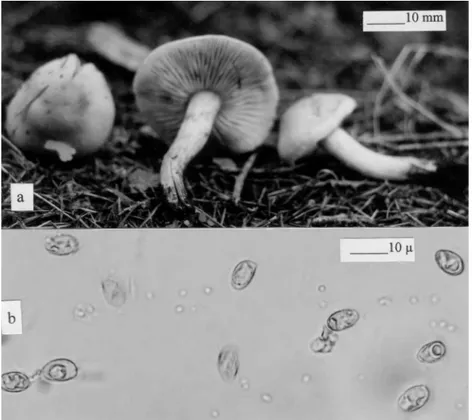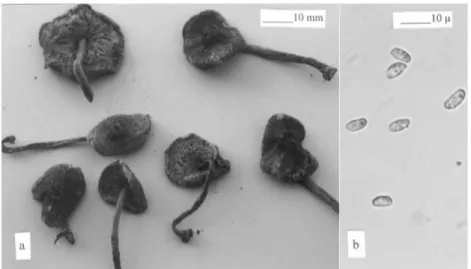Introduction
During field studies from 1998 to 2001, macrofungi specimens were collected from Balıkesir province. Among these specimens 4 new taxa records for Turkey were determined.
Many species of macrofungi growing in Balıkesir have already been reported (Yılmaz et al., 1997; Aflkun & Iflılo¤lu, 1997; Iflılo¤lu et al., 2001, 2001a; Yılmaz & Iflılo¤lu, 2002; Solak et al., 2002), resulting in a list of 200 taxa. For Turkey, many studies on macrofungi have been carried out (Mat, 2000), resulting in 300 articles by many scientists and the number of taxa reaching approximately 1300. With this study, 4 new taxa have been added to the macromycota of Turkey.
Materials and Methods
During field studies, the morphological and ecological characteristics of the macrofungi were recorded and photographed in their natural habitats and then they were brought to the laboratory. Their spore prints were
taken and their spores were photographed. Dried specimens were numbered and placed in sealed bags. In addition, they were put into a deep freeze for a week to protect against internal and external parasite attacks.
The specimens were identified with the help of macroscopic and microscopic features. Keys by Marchand (1980), Phillips (1981), Moser (1983), Breitenbach & Kränzlin (1984), Vesterholt (1989), Zhishu et al. (1993) and Heilmann-Clausen (2000) were used. All specimens collected are preserved in the fungarium of Mu¤la University.
Results
The newly recorded taxa from this research area, and their descriptions, synonyms, localities, photographs, dates of collection and herbarium numbers are given below.
Cortinariaceae
Hebeloma mesophaeum (Pers.) Fr. var. lacteum Vesterh.
Turk J Bot 29 (2005) 333-336 © TÜB‹TAK
333
New Records for the Macromycota of Turkey from Bal›kesir
Province
Fadime YILMAZ ERSEL
Fungus Program, Ula Ali Koçman Vocational High School, Mu¤la University, 48640 Ula, Mu¤la - TURKEY
Received: 05.08.2004 Accepted: 07.04.2005
Abstract: Macrofungi samples recorded in this study were collected from different localities in Bal›kesir province from 1998 to 2001. As a result of the field and laboratory studies, 4 taxa belonging to 4 families were recorded for the first time in Turkey. These are Hebeloma mesophaeum (Pers.) Fr. var. lacteum Vesterh., Lepiota griseovirens Maire, Lactarius violascens (J.Otto) Fr., and Melanoleuca griseofumosa Secr. ex Singer & Clémençon.
Key Words: Turkish macromycota, Taxonomy, Basidiomycetes
Bal›kesir ‹li’nden Türkiye Makromikotas› ‹çin Yeni Kay›tlar
Özet: Bu çal›flmada kaydedilen makrofungus örnekleri 1998 ile 2001 y›llar› aras›nda Bal›kesir ilinin farkl› lokalitelerinden toplanm›flt›r. Arazi ve laboratuar çal›flmalar› sonucunda 4 familyaya ait 4 takson Türkiye’de ilk kez kaydedilmifltir. Bunlar Hebeloma mesophaeum (Pers.) Fr. var. lacteum Vesterh., Lepiota griseovirens Maire, Lactarius violascens (J.Otto) Fr., ve Melanoleuca griseofumosa Secr. ex Singer & Clémençon’dir.
Anahtar Sözcükler: Türkiye makromikotas›, Taksonomi, Basidiomycetes
Cap 30-50 mm, convex to expanded, whitish to cream, centre light brown, surface smooth, viscid when moist, dull silky, margin inrolled to incurved. Lamellae dirty cream, then dark beige, somewhat punctuated brownish, almost without smell. Stipe cylindric, the same colours as cap, older stipe browning at base (Figure 1a). Spores 8-10 x 5-6.5 µ, plum shaped, smooth (Figure 1b).
Balıkesir, De¤irmenbo¤azı picnic area, north of the children’s playground, in pine forest, 28.11.1998, FY 752.
Lepiotaceae
Lepiota griseovirens Maire
Cap 15-25 mm, convex to expanded, markedly umbonate, surface conspicuously covered with small grey-green scales, olive black in apex. Lamellae cream to ochre, darkening slightly at maturity. Stipe 3-5 x 20-40 mm, cylindric, sometimes slightly bulbous, at base same colour as cap, paler in apex (Figure 2a). Smell unpleasant. Spores 6-8 x 3-4 µ, slightly angular, hyaline dextrinoid (Figure 2b).
Balıkesir, De¤irmenbo¤azı picnic area, east of the watchman’s hut, under cedar trees, 09.11.1998, FY 723.
Russulaceae
Lactarius violascens (J.Otto) Fr.
Syn: Lactarius uvidus var. violascens (J.Otto) Quél. Cap, 50-120 mm, convex with a slightly depressed centre, margin at first decurved but gradually expanding, surface smooth, viscid, ochre-grey-brown to brownish violet, zonate. Lamellae broadly adnate to decurrent, crowded, pale cream to ochre, old dark and often rusty-spotted, when bruised turning vinaceous purple to slate purple. Stipe 30-40 x 12-20 mm, cylindric or tapering downwards, surface smooth, dry, pale cream, then cream to greyish buff, with yellowish brown spots at the base, bruised places turning slate purple to dark livid red, flesh elastic, hollow in the stipe, white, then slowly turning greyish lilac to dark purple. Milk white (Figure 3a), taste mild. Spore print pale cream. Spores 8-11 x 6.5-8.5 µ, subglobose to ellipsoid, ornamented (Figure 3b). New Records for the Macromycota of Turkey from Bal›kesir Province
334
F. YILMAZ ERSEL
335
Figure 2. Lepiota griseovirens a. Fruiting body b. Spores.
Figure 3. Lactarius violascens a. Fruiting body b. Spores.
Figure 4. Melanoleuca griseofumosa a. Fruiting body b. Spores.
_ _ 10µ
_ _ 10µ
Balıkesir, Balıkesir-Susurluk road, 25 km, under bushes, 17.11.1998, FY 778.
Tricholomataceae
Melanoleuca griseofumosa Secr. ex Singer & Clémençon
Cap 30-40 mm, convex when young, later plain and sometimes indented in the centre and somewhat obtusely umbonate, shield shaped, surface smooth, dull, silky, lighter grey, centre darker, margin incurved and
somewhat frosted. Lamellae broadly adnate, white, pruinose light grey-cream. Stipe 3-4 x 40-60 mm, cylindric, slightly enlarged toward the base, grey, surface longitudinally grey-brown fibrillose, finely pruinose (Figure 4a). Flesh grey to whitish. Spores print cream. Spores 7.5-8 x 4.5-5 µ, elliptical, smooth (Figure 4b). Cystidia spindle shaped.
Balıkesir, De¤irmenbo¤azı picnic area, east of the watch-tower, mixed forest, 12.01.2001, FY 1108. New Records for the Macromycota of Turkey from Bal›kesir Province
336 References
Aflkun T & Iflılo¤lu, M (1997). Macrofungi of Balya (Balıkesir) Counry. Turk J Bot 21: 279-284.
Breitenbach J & Kränzlin F (1984-1991). Fungi of Switzerland. Vol. 1-3, Lucerno: Verlag Mycologia.
Heilmann-Clausen J, Verbeken A & Vesterholt J (2000). The Genus Lactarius. Denmark: Jens H. Petersen/ Low Budget Publishing. Iflılo¤lu M, Yılmaz F & Merdivan M (2001). Concentration of trace
elements in wild edible mushrooms. Food Chemistry 73: 169-175.
Iflılo¤lu M, Merdivan M & Yılmaz F (2001a). Heavy metal contents in some macrofungi collected in the northwestern part of Turkey. Archives of Environmental Contamination and Toxicology 41: 1-7.
Marchand A (1980). Champignons du nord et du midi, Lactaires et Pholiotes. Tome 6, Perpignan: Société Mycologique des Pyrénées Méditerranéennes,
Mat A (2000). Türkiye’de Mantar Zehirlenmeleri ve Zehirli Mantarlar. ‹stanbul: Nobel Tıp Kitabevleri Ltd. fiti.
Moser M (1983). Keys to Agarics and Boleti. London: Gustav Fisher Verlag.
Phillips R (1981). Mushrooms and Other Fungi of Great Britain and Europe. London: Pan Books Ltd.
Solak MH, Yılmaz Ersel F, Gücin F & Iflılo¤lu M (2002). Macrofungi of Balıkesir Province from Turkey. Bio-Science Research Bulletin 18(2): 137-149.
Vesterholt J (1989). A revision of Hebeloma sect. Indusiata in the Nordic countries. Nordic J Bot 9: 289-319.
Yılmaz F & Iflılo¤lu M. (2002). Macrofungi of De¤irmenbo¤azı (Balıkesir). Turk J Bot 26: 161-164.
Yılmaz F, Öder N & Iflılo¤lu M (1997). The macrofungi of Soma (Manisa) and Sava?tepe (Balıkesir) District. Turk J Bot 21: 221-220.
Zhishu B, Guoyang Z & Taihui L (1993). The Macrofungus Flora of China’s Guangdong Province. Hong Kong: The Chinese University Press.

